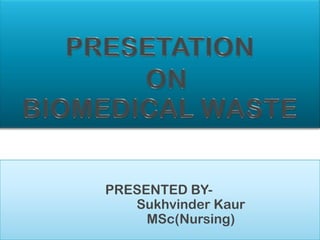
Biowaste
- 1. PRESENTED BY- Sukhvinder Kaur MSc(Nursing)
- 2. Biomedical waste is defined as solid waste generated during the diagnosis, testing, treatment, research or production of biological products for humans or animals. Biomedical waste includes syringes, laboratory samples, body parts, bodily fluids and sharp needles.
- 3. The main sources of biomedical waste are: Hospitals Medical clinics Laboratories
- 4. Waste management can be done by a systematic approach, which involves: Segregation: Segregation is to be done at source of generation of biomedical waste by the medical & para-medical staff. Collection: Collection of biomedical waste should be done as per rules of
- 5. biomedical waste management & Handling (1998) notified under the environment protection act by the ministry of environment. Transportation of hospital waste can be done: Within the hospital At the treatment / Disposal unit outside the hospital
- 6. Treatment of hospital waste: Approaches of treatment may differ according to: General waste Biomedical waste
- 7. Treatment Option & Waste Category Disposal Cat. No. Incineration Human Anatomical Waste 1 /deep burial (human tissues, organs, body parts) Cat. No. Incineration Animal Waste (Animal 2 /deep burial tissues, organs, Body parts bleeding parts, body fluids, blood and experimental animals used in research,
- 8. Treatment Option & Waste Category Disposal discharge from hospitals, animal houses) Cat. No. Local Microbiology & 3 autoclaving/ Biotechnology waste (wastes micro- from laboratory cultures, or waving/ specimens of micro- incineration organisms, live or attenuated vaccines, human and animal cell culture used in research
- 9. Treatment Option & Waste Category Disposal and industrial laboratories, wastes from production of biological, toxins, dishes and devices used for transfer of cultures) Cat. No. Disinfection Waste Sharps (needles, 4 (chemical syringes, blades, glass that treatment/ may cause puncture and autoclaving cuts. This includes both
- 10. Treatment Option & Waste Category Disposal used & unused sharps) Cat. No. Incineration Discarded Medicines and 5 or Cytotoxic drugs (wastes destruction comprising of outdated, & drugs contaminated and discarded disposal in medicines) secured landfills
- 11. Treatment Option & Waste Category Disposal Cat. No. Incineration Solid Waste (Items 6 /autoclaving contaminated with blood and /micro- body fluids including cotton, waving dressings, soiled plaster casts, beddings) Cat. No. Disinfection Solid Waste (waste 7 by chemical generated from disposable treatment items other than the sharps wastes such as tubing,
- 12. Treatment Option & Waste Category Disposal intravenous sets etc.) Cat. No. Disinfection Liquid Waste (waste 8 s by generated from laboratory & chemical washing, cleaning ,house- treatment keeping and disinfecting and activities) discharge into drain
- 13. Treatment Option & Waste Category Disposal Cat. No. Disposal in Incineration Ash (ash from 9 municipal incineration of any bio- landfill medical waste) Cat. No. Chemically Chemical waste (chemicals 10 Rx used in production of disinfection biologicals, chemical used in & discharge insecticides etc) into drains for liquid
- 14. NOTE: Chemicals treatment using at least 1% hypochlorite solution or any other equivalent chemical reagent should ensure the disinfection. Mutilation/shredding must be such so as to prevent unauthorized reuse. There will be no chemical pretreatment before incineration. PVC shall not be incinerated.
- 15. The central pollution board has recommended two types of incinerators : Incinerators for individual hospital/nursing homes/ medical establishments Common incinerator to handle waste. from a number of hospitals/nursing homes /pathological laboratories etc.
- 17. Color Type of Waste Treatment Coding Container Category Options Yellow Plastic bag Categories Incineration/ 1,2,3 & 6 deep burial Red Plastic bag Categories Autoclaving/ 3,6,7 Micro waving/ Chemical Treatment Blue/white plastic bag/ Categories Autoclaving/ Translucen puncture 4,7 Micro waving/ -t proof chemical containers treatment
- 18. Color Type of Waste Treatment Coding Container Category Options Blue/ Plastic Categories Autoclaving/ White bag/puncture 4,7 Micro translucen proof waving/ -t container chemical treatment and destruction Black Plastic bag Categories Disposal in 5,9,10 secured (Solid) landfill
- 19. Different labels for bio-medical waste container & bags shall be require for identification & safe Handling of this waste. These labels for storage /Transportation of biomedical waste are as:
- 20. All items sent to incinerator/burial to be placed in yellow colored bags. All biomedical waste to be sent for microwave/ autoclaving/chemical treatment to be packed in a blue/white translucent bags.
- 21. Any other waste to be sent to shedder after autoclaving/chemical treatment to be packed in black bag. All bags /containers are to be filled up only 3/4th capacity & removed from the site of generation regularly &timely. Wastes that require decontamination/ disinfection at the site of generation (plastic or sharp materials should be removed only after treatment)
- 22. Indicators Checklist Indicator 1 Sharp instruments are handled safely to minimize the risk of a sharp injury: Appropriate puncture-proof sharp containers. Container less than three-quarters full. No recapping or one-hand recapping. Indicator 2 Instruments decontaminated fully: Sterilizer available & in good
- 23. Indicators Checklist working order Equipment thoroughly cleaned after use. Clean instruments are stored in cupboards. Indicator 3 Hands are washed appropriately to prevent cross infection: Soap & water available. Clean towels available. Staff observed to wash and dry hands after
- 24. Indicators Checklist contact with body Fluid, removal of gloves & contact with patients. Indicator 4 A protective barrier is to worn to prevent exposure to blood The following protective barriers are available for use by staff (Depending on the clinical area & risk of exposure) Disposable gloves Heavy duty gloves Masks
- 25. Indicators Checklist Protective eyewear Indicator 5 Waste disposal safety: Evidence of deep burial or burning regularly. No contaminated waste visible
